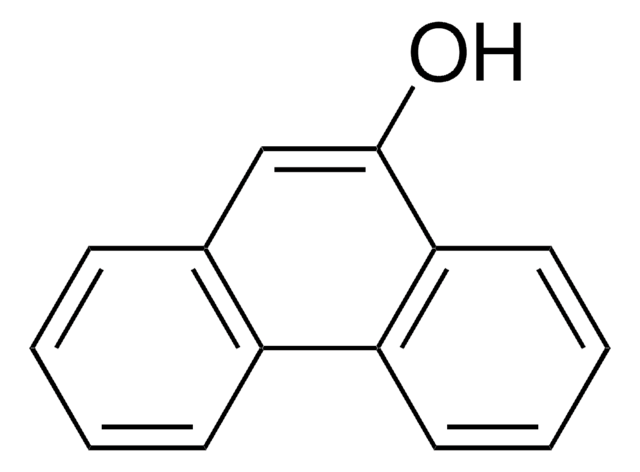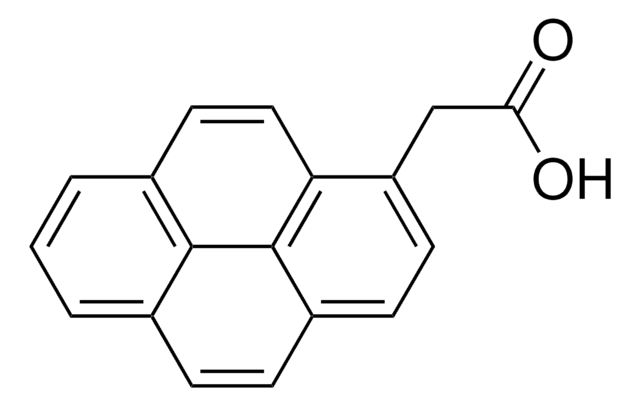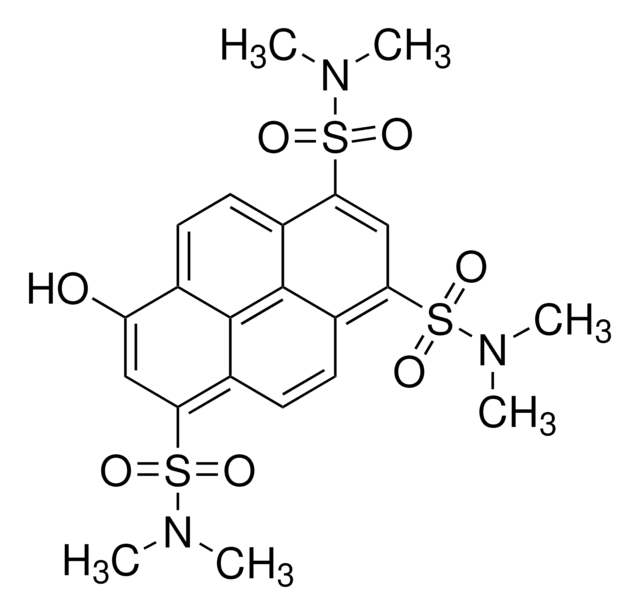All Photos(1)
About This Item
Empirical Formula (Hill Notation):
C16H10O
CAS Number:
Molecular Weight:
218.25
MDL number:
UNSPSC Code:
12352100
PubChem Substance ID:
NACRES:
NA.22
Recommended Products
Assay
98%
mp
179-182 °C (lit.)
SMILES string
Oc1ccc2ccc3cccc4ccc1c2c34
InChI
1S/C16H10O/c17-14-9-7-12-5-4-10-2-1-3-11-6-8-13(14)16(12)15(10)11/h1-9,17H
InChI key
BIJNHUAPTJVVNQ-UHFFFAOYSA-N
Looking for similar products? Visit Product Comparison Guide
General description
1-Hydroxypyrene, as a urinary metabolite, is a marker of polycyclic aromatic hydrocarbons (PAH) exposure. 1-Hydroxypyrene is an important biomarker of exposure to pyrene.
Application
1-Hydroxypyrene is suitable for use in following studies:
- To investigate the fast detection and quantification of 1-hydroxypyrene in tissue extracts from Nereis diversicolor exposed to sediment-associated pyrene by a simple fluorometric method.
- To investigate the effects of genetic polymorphisms of the cytochrome P450 1A1 (CYP1A1) and 2E1 (CYP2E1) and glutathione S-transferases mu (GSTM1) and theta (GSTT1) on urinary 1-hydroxypyrene and 2-naphthol levels in aircraft maintenance workers.
- To examine the the PAH exposure of cokery workers in an Estonian oil shale processing plant.
Storage Class Code
11 - Combustible Solids
WGK
WGK 3
Flash Point(F)
Not applicable
Flash Point(C)
Not applicable
Personal Protective Equipment
dust mask type N95 (US), Eyeshields, Gloves
Certificates of Analysis (COA)
Search for Certificates of Analysis (COA) by entering the products Lot/Batch Number. Lot and Batch Numbers can be found on a product’s label following the words ‘Lot’ or ‘Batch’.
Already Own This Product?
Find documentation for the products that you have recently purchased in the Document Library.
Customers Also Viewed
Zheng Li et al.
Chemical research in toxicology, 25(7), 1452-1461 (2012-06-06)
Human exposure to polycyclic aromatic hydrocarbons (PAHs) can be assessed by biomonitoring of their urinary monohydroxylated metabolites (OH-PAHs). Limited information exists on the human pharmacokinetics of OH-PAHs. This study aimed to investigate the excretion half-life of 1-hydroxypyrene (1-PYR), the most
Heiman F L Wertheim et al.
Environmental health : a global access science source, 11, 72-72 (2012-09-28)
Urban air pollution is an increasing health problem, particularly in Asia, where the combustion of fossil fuels has increased rapidly as a result of industrialization and socio-economic development. The adverse health impacts of urban air pollution are well established, but
Thomas W Fuller et al.
Scientific reports, 8(1), 507-507 (2018-01-13)
Electronic cigarette (EC) use is gaining popularity as a substitute for conventional smoking due to the perception and evidence it represents a safer alternative. In contrast to the common perception amongst users that ECs represent no risk initial studies have
Yan S Ding et al.
International journal of environmental research and public health, 11(11), 11898-11914 (2014-11-21)
Cigarette smoke is a known source of exposure to carcinogenic polycyclic aromatic hydrocarbons (PAHs), especially benzo[a]pyrene (BaP). Exposure to BaP in cigarette smoke is influenced by how a person smokes and factors, such as tobacco blend. To determine whether sustained
P Strickland et al.
Toxicology letters, 108(2-3), 191-199 (1999-10-08)
Humans are exposed to polycyclic aromatic hydrocarbons (PAHs) from occupational, environmental, medicinal and dietary sources. PAH metabolites in human urine can be used as biomarkers of internal dose to assess recent exposure to PAHs. The most widely used urinary PAH
Our team of scientists has experience in all areas of research including Life Science, Material Science, Chemical Synthesis, Chromatography, Analytical and many others.
Contact Technical Service















